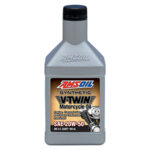06 Sep Amsoil Excels in V-twin Torture Test
Extreme heat is the biggest enemy for a powerful air-cooled V-twin engine, like Harley-Davidson* motorcycles. So, Amsoil put it through the V-Twin torture test
Extreme Heat Can Ruin Your Ride
When designing its latest V-twin engine platform – the Milwaukee Eight* – Harley asked riders what they wanted from its newest engine: More power and less heat so Amsoil performed the V-Twin Torture Test.Some riders have complained about intense heat radiating from the engine while riding, particularly the rear cylinder, which doesn’t receive as much airflow as the front cylinder. Extreme heat not only challenges rider comfort, it challenges the engine. If heat causes the piston to expand beyond acceptable tolerances, it can rub against the cylinder wall and cause scuffing. Heat also causes some oils to thin and lose viscosity. The oil can become so thin the engine loses oil pressure, causing the oil-pressure gauge to bottom out.
Riding Conditions Turn Up The Heat
V-twin heat becomes especially problematic when riding on hot summer days in conditions that limit airflow over the engine, such as in slow-moving parade or rally traffic. In extreme cases, the bike’s electronic temperature controls shut down the bike if it gets too hot.
Oil-cooled Milwaukee-Eight engine
Harley introduced its Milwaukee-Eight engine in 2016 in part to reduce extreme heat and enhance rider comfort. The engine uses a system of oil-filled cooling jackets surrounding the cylinders to reduce heat. The oil absorbs heat and carries it to a small oil cooler, where it dissipates into the atmosphere.
1,000-mile dyno test (left-click for Video))
To test AMSOIL Synthetic V-Twin Motorcycle Oil in the latest V-twin technology, Amsoil purchased a 2019 Harley- Davidson Street Bob equipped with a 107-c.i. Milwaukee Eight engine.
Davidson Street Bob equipped with a 107-c.i. Milwaukee Eight engine.
Amsoil instrumented the bike and rode it on the street to establish a baseline for “real-world” operation. This confirmed that low-speed, low air-flow conditions, like stop-and-go traffic, created the most challenging conditions. Amsoil then installed the bike on the dyno in the mechanical lab and subjected it to a 1,000-mile test designed to simulate the worst-case street conditions. One thousand miles is enough to make 640 trips down Main Street in Sturgis.
Airflow over the engine was restricted to hold the oil-sump temperature at a steady 300ºF (149ºC). Cylinder temperature topped out at 421ºF (216ºC). In these conditions, the oil can quickly oxidize (chemically break down), which causes the viscosity to increase until it’s out of grade and no longer provides the protection the engine requires.
Extreme Heat No Match For AMSOIL
Following the test, the lab chemically analyzed the oil to measure viscosity, oxidation, total base number (TBN) and wear metals. Also examined for wear or distress, was engine parts and compensator, .
AMSOIL 20W-50 Synthetic V-Twin Motorcycle Oil (MCV) provided exceptional protection. The piston skirt contains virtually no wear, while deposits are minimal given the extreme conditions. The rings still moved freely for maximum compression and power. The wear surfaces on the compensator are also in excellent condition, indicating the oil provided smooth, reliable shifts.

